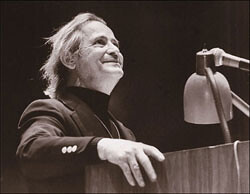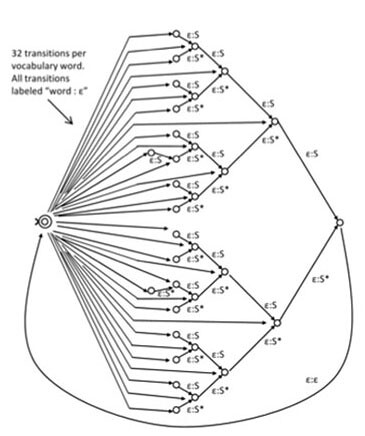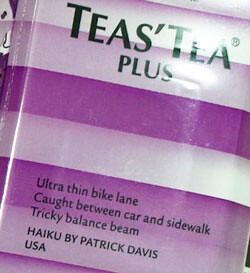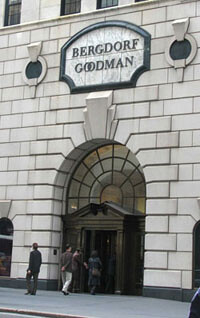Last year, Triple Canopy published Alix Rule and David Levine’s “International Art English.”1 As a broad critique of globalized artspeak semantics, the essay has since sparked many debates around the exaggerated claims and imprecise promotional language of contemporary art. In this issue of e-flux journal, Martha Rosler and Hito Steyerl each respond to Rule and Levine’s essay.
***
If one examines Lacanist obscurity, one is faced with a choice: either reject capitalist Marxism or conclude that the significance of the poet is social comment. However, if neodialectic cultural theory holds, we have to choose between subdialectic narrative and capitalist deappropriation. Marx suggests the use of the precultural paradigm of discourse to challenge class divisions.2
In 1974, Thomas Pynchon sent Irwin Corey to Lincoln Center to accept the National Book Award citation for Pynchon’s novel Gravity’s Rainbow. Corey was a nationally known comic monologist billed as Professor Irwin Corey, the World’s Greatest Expert. He regularly delighted corporate audiences with double-talk speeches couched in the linguistic codes of their own fields of expertise. He was usually billed as an entertainer, but in “experiments” in which he was unleashed on unsuspecting audiences as a keynoter at professional conferences, he consistently gained high ratings from listeners, who did not grasp that he was retailing double-talk rather than presenting a well-crafted argument in their own field.3


I was prompted to write the present article by a request to participate in a public conversation addressing Alix Rule and David Levine’s article “International Art English,” published in Triple Canopy. I was unable to participate but wound up jotting down some notes that led to this effort; my response is meant as complementary to Hito Steyerl’s essay, which takes a very different tack. While I reserve the right to consider the original article as an elaborate joke, one hardly needs to be reminded that jokes are often a cover for hostility, and the more elaborate the joke, the more powerful the hostility may be. Furthermore, jokes are often intended to forge an alliance between the teller and the listener, at the expense of the butt of the joke. It’s one thing to critique double-talk as gobbledygook, a meaningless jumble of memes and phrases. It’s another to shine a negative spotlight on the word salad as a way of proving that theoretical discourse, or the very enterprise of theory, is a sham and a shame, a foreign import, or perhaps simply a fallen discourse.
At the turn of the twentieth century, millions of Europeans immigrating to the US were subjected, along with their children, to “Americanization,” which rested on learning English, and with it the rationalized work discipline and obedience of office, factory, and retail workplaces, all of it orchestrated and presided over by experts. Management culture, still in its infancy, was an integral element of turn-of-the-twentieth-century industry, leading to the reworking of systems of shop-floor control such as obtained in the steel industry, and the intrusion of “efficiency experts” who came up with motion- and time-management systems, from time cards to rationalized movement to output demands. There developed one understanding of the English language as a privileged, historically rich, and expressive vehicle4 but also another understanding, a twin-set: an instrumentalized language of control and its corollary language of simplified commands.


Expert culture and its workplace effects have been pilloried, parodied, and burlesqued in many artworks, including Chaplin’s Modern Times, Kingsley Amis’s I’m All Right Jack, Cheaper By the Dozen (a friendly, comic look at the home life of motion-study experts Frank and Lillian Gilbreth and their twelve children, with the movie based on the book by a few of the children), Spotswood (or, The Efficiency Expert), and Desk Set (where the villain is a computer, as it is in 2001: A Space Odyssey). In films like Die Blaue Engel and His Girl Friday, the professorial expert or his jargon is the target, as it is much earlier in the ridiculous figures of Hamlet’s Polonius, Voltaire’s Dr. Pangloss, the Houyhnhnms encountered by Gulliver—and surely somewhere in the Greek and Roman plays and in every other culture with hierarchies, stratifications, and so forth, which breed their own discourses of power and jargons of access in exercising control over the workforce, whether slaves, contract workers, piece workers, assembly-line workers, service workers, or wage slaves. If Professor Irwin Corey (a lifelong radical who appeared at Liberty/Zuccotti Park in 2011, at age 97, to cheer on Occupy Wall Street) is a representative symbolic figure of that understanding of discourses of power, Reggie Watts (b. 1972), fusing multilingual double-talk with scat singing and musical riffs, may be the best or at least the most prodigious contemporary successor.5 Such parodic performances will not vanish soon; the discursive codes of management and the pretentious patter of the hypereducated are robust. One is always trying to get ahead of them, and those subjected to them can mock them with a burlesque flourish or with the scathing mimicry of the outraged. Conversely, the working stiff who cannot make the grade is a perennial object of ridicule, gentle or otherwise; cases in point: Homer Simpson and his spiritual forebear, the aircraft-wing riveter Chester A. Riley.6 In this they join those others outside the wage scale, that is women, old people, and children.


The universe of consumption provides a host of areas in which specialized language has great appeal. Nothing shows the power of “expertise” more than organized sports, and men (primarily), young and old, learn to parse not only the precise rules but also the quantified actions and technical descriptions of sports, with their recollections of military formations. For the more pacific-minded, there is the language of film and television production, recently augmented by computer-derived jargons.
Migration of restricted discourses signifying expert engagement, however, requires more than a mastery of linguistic tropes; to avoid sounding ridiculous, one must learn when, where, and whether to deploy the terminology. Imitation, by cliché the sincerest form of flattery, may produce tortured language that unintentionally exposes one’s shortcomings. People aiming to sound learned or informed are often not very good at their highfalutin borrowings.
There are also those among the educated who hope to advance professionally by analyzing other disciplines’ inelegant linguistic peccadillos. Efforts to quantify linguistic patterns are surely deserving of suspicion when not done by law enforcement trying to track down a note-writing desperado or in cryptanalysis to decode a cipher, or in pursuit of another forensic usage, such as attempting to ascertain authorship.
I’ve tried one of these. When I was an undergraduate at Brooklyn College, I was persuaded by my sociology tutor to perform a statistical analysis of a poem7; I chose the canonical Tintern Abbey by Wordsworth. I can’t recall the parameters of the analysis, but both my English tutor and I were embarrassed by the barrenness of the results. The parsing of active/passive and other statistically available measures did not lead me terribly far down the road of “understanding” romantic poetry.


Many years later, in early 2003, I was living in Stockholm and listening to a radio feed of National Public Radio, the American public radio service; the hosts of All Things Considered had asked a Berkeley linguistics professor to expatiate on what we could learn from noting who called the country we had just invaded Eye-rack and who pronounced its name EErock. “Wrong question!” I wanted to yell at the radio. Once again, I felt embarrassed by the inappropriate approach to matters linguistic, and this time it felt like a public shaming: this was what was broadcast to the world about the approach of “my fellow Americans” to matters of invasion and destruction.8
In both these instances, the grabbing hold of linguistic tropes did not even manage to grasp the narrative. Instead, it amounted to a sleight of mind, a diversionary trick without a meaningful outcome. With respect to my own low-level Wordsworth analysis, it’s possible that, thanks to the scientism of the day, a statistical take might have seemed to give the analyst a jump on the messy contingency of reading, especially in contrast to the belletrist or New Criticism–based study of holy secular English literature in that pre-postmodern moment.9 With respect to the Eye-rack /EErock divide, that might tell us a little about those who were either reporting on, reacting to, or fighting the war (a back door to a class analysis, perhaps), but this was no-news passing as news, and I was upset at the nice professor who had been persuaded to tell us about it in a serious tone of voice. Neither linguistic geography nor social-class usage would equip us to learn much about the real-world exigent politics. In both cases, fixing on words in a sanitized manner rendered them peripheral rather than central to illuminating either a question of poetry or one of a gigantic, ongoing international war crime.
In the early 1970s, we experienced a moment much like the present one, in which the middle class discovers it really, really loves food, expensive food that helps its eaters feel superior to lesser eaters the way saying EErock can make you feel superior to those who say Eye-rack. Back then, this food was not mere food but cuisine, the product of artistry and imagination. It smacked of magic even more than skill and might be considered virtuous in its relation both to producers and to the earth, as well as providing health-giving maintenance for one’s precious bodily temple.10
We used to joke that every adjective added to a dish on a chain-restaurant menu added another dollar to its cost. The temptation to pile on the adjectives persists. Here’s a restrained example from the current menu of the Denny’s in Cambridge, Maryland:
THREE-DIP & CHIPS
Three delicious flavors—mild salsa, queso con carne and warm, creamy spinach artichoke. Served with crispy tortilla chips.
A somewhat more up-market café lists “Grass-fed organic bison with sautéed mushrooms and melted Swiss on a home-baked roll.”
Fascinated by the visual and verbal representations of food and its cultural roles, in 1974, as part of a multi-course performance/installation work based on the semiotics of the menu and the dish,11 I and a male partner alternated in reciting a list of adjectives for food drawn from aspirational cookbooks and articles: ambrosial, aromatic, awe-inspiring, choice, croquant, dainty, dazzling, delectable, dreamy, dulcet, divine, epicurean, exquisite, and so forth. The list was long. Some of its less recherché words can today be found online; one blog writer commented: “I taught a class on Hotel and Restaurant English a little over a year ago at my college and created a list of food descriptors for a Hotel and Restaurant ESL class.” We’ll get to ESL in a moment.


Descriptive terms and phrases are the coin of the realm for copywriters, especially at demotic levels. Sniffing after the trail of press-release copy in the search for a diagnosis of a perceived art-world malady seems to misconstrue what a press release is and what it is designed to do or to be. It hardly needs to be said that a press release is a long-form piece of advertising copy, with embedded keywords. This is such a commonsensical understanding of linguistic folderol that moving the subject to the art-world press release impels the writers of the article under dissection here to try to reassure us, their readers, that what they are doing is not in fact merely a silly game—when it may very well be merely a silly game (cf. Irwin Corey).12
Our diagnosticians note but may not quite understand that global English is a necessarily simplified language, most useful for communicating simple ideas and instructions. Below the guild secrecy of restricted linguistic codes is the lexicon I referred to earlier, the one tailored to develop the subject position of controlled employees and others.13 A reduced vocabulary is used to communicate instructions, and nowadays these instructions are likely to be in English. No surprise that in the present conjuncture, a simplified international English has been developed as an instrumentalized language meant to enable non-native speakers or relatively uneducated or even just young people to understand and perhaps follow simple instructions.
On the website Simplified English: Key to Successful Internationalization, we find the following:
As usability professionals [sic] we know that making text understandable is very challenging, especially in an international environment. Simplified English can help. It was developed to facilitate the use of maintenance manuals by non-native speakers of English. Aerospace manufacturers are required to write aircraft maintenance documentation in Simplified English which:
reduces ambiguity,
speeds reading,
greatly improves understanding for people whose first language is not English,
makes translation cheaper, easier and allows automated translation.How it works:
It starts with a lexicon of approved words,
Each word can only be used as the part of speech as defined:
“close” is a verb, so: “Close the door” is correct, “do not go close to the landing gear” is wrong, “do not go near the landing gear” is acceptable.Words can only be used with the approved meaning:
“Follow” means to come after, so: “the puppy follows the adult,” is correct, “follow the safety rules” is wrong, “obey the safety rules” is acceptable.14
The site produces the following transformation of a paragraph:
Place the water heater in a clean, dry location as near as practical to the area of greatest heated water demand. Long uninsulated hot water lines can waste energy and water. Clearance for accessibility to permit inspection and servicing such as removing heating elements or checking controls must be provided.
Put the water heater in a clean, dry location near the area where you use the most hot water. If the hot water lines are long and they do not have insulation, you will use too much energy and water. Make sure you have access to the heating elements and the controls for inspection and servicing.
Applying the Flesch-Kincaid Reading Ease score, we find the first selection scored thirty-four out of one hundred, with one hundred being most readable (readability increases as the numbers rise).15 On the Flesch-Kincaid grade-level index, the original paragraph drew a grade level of thirteen. Rewritten, the paragraph’s reading-ease score had risen to fifty-five, and its grade level had dropped to ten.


The poetics of instruction manuals reside mostly in the boldly non-Standard imported instructions such as those found in quite a few Asian-manufactured goods. Look up “Chinglish” on Wikipedia and you will find a distinction between “instrumental” and “ornamental”; in the latter instance, an almost randomly selected English word put in adjectival position will elevate the worth of a common item, much as restaurants use smooth and crispy or braised or hand-picked to raise the status and price of a common-enough menu item (or more appositely, the way finger-lickin’ or lip-smackin’ help propel the hordes to the drive-through fast-food window). The fetishistic use of word tokens as keywords is so widely recognized that websites abound that offer “postmodernism generators” and other triplet combinations of recognizable jargon (adverb, adjective, noun).16
After guiding us through the putative sources of the international linguistic code as used in generally nonprofessionally written press releases for small art venues, the article under discussion here finally reveals to us that the reductive use of this residual vocabulary of Continental theory is so literally uninformative that it amounts to an inadvertent poetry of sorts.
But ornamental language always strives for a poetics; as I’ve maintained, the language is meant not so much as a validation but as a way of signaling the elevated niche in the particular universe of discourse in which the writer hopes to position the work in question. (Even the New York Times has a blog devoted to the “Haiku of the Day” drawn from headlines and copy in the day’s paper, and the definitively middlebrow public radio conglomerate WNYC runs promos featuring broadcasters cooing out endorsement “haikus” sent by donors. A hipster-oriented kefir company in New York prints a consumer haiku on its cartons.) Haiku is claimed by the “creative class” as the “quick” equivalent of noncommodified production.


Perhaps these flights of fancy represent the underpaid, unspecialized copywriters’ attempts to pull away from the clichés of the approved list and at the same time offer readers a tacit acknowledgment that the language, while space-filling, is neither particularly informative nor meaningful. The international language-instruction chain Wall Street English, while featuring the British Union Jack in its logo—a powerful symbol of imperial dominion and propriety above all—reminds you by its very name that the point is Wall Street, i.e., financial acumen; learning the English lingua franca their way will provide you with an entrée into the transnational world of money. If you consider the echoes of Continental philosophy to signal debased or fallen language, one wonders where else the writers of art ad copy would find their vocabulary of approbation. But what inevitably happens to the pidgins of a global argot—“Roman,” I’ve often called our international global English—is that its users lose the poetics of a half-learned phrase as they are trained to professionalize and adopt the language of the proper social class of speakers, thereby losing the appeal of naive strivers, Others Who Fail. As a lieutenant class arises, its members, buckling down to the inevitable lessons of work discipline and consumer discipline, simply get better at writing the instruction booklet and the descriptive sales pitch aimed at keeping, in Pierre Bourdieu’s phrase, “the market in symbolic goods” properly cordoned off and its discourses shielded from the speech of the street or even the market.
High-end venues, of course, do not need to pile on the descriptors; they don’t have to try so hard. They don’t even need to advertise on e-flux, when they can buy an ad in Artforum or pay a critic to write an article of praise. They have established a reputation, and a rich clientele is not swayed by linguistic bling. To those folks, spending money comes easier, and designer words require no added emphasis.


To continue the culinary example, here’s a brief selection from the renowned Four Seasons restaurant in Manhattan:
Paillard of Beef chimichurri $55.00
Filet of Bison foie gras, perigord black truffles $65.00
Three Lamb Chops roasted barley-root vegetables $65.00
Ahi Burger mango-red onion salsa $28.00
Sirloin Burger onion-thyme relish $38.00
If someone wants to complain that the art market has so distorted the art world that all we have left in the wake of the death of critical engagement is the cannibalization of theory into a string of faux freshwater pearls, it would be better, I should think, to put together an article exploring that subject. This would be preferable to basing a critique on a statistical model, or worse, to comparing the sales pitches of hapless, underpaid, non-native English speakers to pornography. (A reminder here that for Kant, the faculty of taste saves us from the pornographic—roughly the desire to reach out and touch the object of aesthetic representation. Taste has been resurrected, in what might be called the biopolitical era, as the individual’s signature internal method of discerning the good amidst the field of the bad. I idly speculate that the article’s authors wish us to find lurking under debased copy its users’ inferior taste because their writing flows from an inauthentic borrowed source.)
If, on the other hand, you want to go after international uses of English, here’s a thought: it appears that the former English colonies in which English is the primary language and in which the art world lacks a significant indigenous market and in which national (as opposed to minority-discourse ethnic) identity politics will get you nowhere, are hoping to dupe people into a painful form of credentialism, persuading them that somehow obtaining a doctorate in studio art will make you a better, more employable and “showable” person—an international player. This amounts to teaching an up-sized version of Simplified Art Copywriting, which one can apply to oneself and one’s projects.17 In some places this mincing jargon will land you a curatorial job. But it doesn’t hold a candle to some of the brain-swelling gibberish that young art historians and curators—graduates of the very best elite US universities who were also committed to Occupy Wall Street—occupied themselves with in emails and Facebook chains during the high moments of the movement in fall 2011, scholastic strings of reasoning so turgid they defied my ability to decipher their meaning or relevance. After a few go-rounds, I withdrew from the conversation I’d been invited to join; similarly, after the first month of receiving e-flux’s announcements a decade or so ago, I opted out of the list.18


Paeans to the glory of the English language periodically circulate.19 The spread of the language may be traceable to colonialism, to be sure, but richness seemed to be the underlying reason for its success, and various English pidgins are adduced to testify to its generative power. In other words, the story of English is an evangelical gospel. In this vein, pidgins and creoles develop spontaneously, and non-English speakers may enroll in Wall Street English lessons, buy Rosetta Stone language programs, or pursue other proprietary ways of learning English as a form of self-advancement or a traveler’s luxury, but the teaching of English as a second language (ESL) is another way to frame methodologies for providing the peons, strivers, and aspirants with the linguistic competence to be functional and compliant.20
I find in the diagnosis of IAE a rigid formalism in which, in Jessica Mitford’s terms, U and non-U21 English signal the status not only of the writers but of the goods themselves, restricted to the delectation of the elite. If the still-inelegant users are to be mocked, one might as well mock the clerks in Bergdorf’s and similar luxury stores who address the customers as moddom as they sweep the goods into and out of the buyer’s sight. This deference is a condition of employment; without it you do not get through the door. Neither October nor the Frankfurt School nor e-flux is responsible for the invention, elevation, or promulgation of Simplified Art Copy and its universalizing usage as the entrée into the art world. It’s structural! Trader’s argot may never have been so widely disseminated, but it is merely symptomatic, a provisional accommodation, and it would be nice to see the malady itself placed at the heart of such a discussion.
What struck me most forcefully about the article was that it churned up enough interest among the chattering class to provoke some members to imagine that the mandarins have something at stake in linguistic ornaments, and that they themselves have something to defend. Given the attacks on the humanities and their funding, those in the art world (and the “human sciences,” including sociology) would, one might think, be more circumspect about picking up some of the tools of the delegitimators, such as statistical analysis. But there are more aggressive “quant” challenges afoot. When Obama rolled out (I use the military metaphor advisedly) his BRAIN initiative—Brain Research through Advancing Innovative Neurotechnologies, or the Brain Activity Map Project—the intended result was not a positive effect on medical research alone. Half the government funding for this field comes from the Pentagon’s Defense Advanced Research Projects Agency (DARPA), and part of that agency’s rationale is the relatively unsubtle enhancement of soldiers’ performance on the battlefield, through the continued development of machine-brain interfaces.22 Neural research is also an important element in the technicalization of “aesthetic” reception, including of literature, of which statistical analysis was an early variant.23 The newer versions acknowledge the popularity of all things “neuro” (except “neurotic,” a terminological/diagnostic remnant of the earlier, humanist approach to the mind). Semir Zeki, Professor of Neuroaesthetics at University College, London—the man who came up with the term “neuroaesthetics” and who has been given a one-million-pound grant to further his research on “the ways in which beauty and art are functions of the physiology of the brain”—has said: “art critics … may [feel threatened by my claim] that I know that most people will respond to the beauty of the human figure when it is painted in a particular way because of the way receptors are distributed,” but it is “auction house directors who should be more fearful”: “Imagine if … you had a priori knowledge of which paintings were actually objectively liked or disliked by people through scanning their reactions, as we may one day be able to do. Values could well change overnight.”24


The effects extend beyond the prestige and funding of humanities departments, long a target of right-wingers, who see “theory” and critical studies as Marxist tinged and socially disruptive, as well they might. While Rule and Levine point the finger at October and theorists such as the Frankfurt School, so do those touting neuroanalysis and neuroesthetics, but with a good deal more scorn and malevolence. Neuroanalysis is also, like much linguistic and information-related research since at least the Sputnik moment, another arm of military-directed research.25 By virtue of hype and funding, it has more appeal than the fusty old cogitations about “texts” and images, in part because we are in another scientistic cultural moment, once again driven in part by the needs of the military—and roundly supported by the pharmaceutical and educational testing industries. A relatively long-standing initiative in this regard came not from the Left-bashers and humanities-haters, but from the Marxist scholar Franco Moretti. Moretti, based at Stanford University, established the Center for the Study of the Novel in 2000 and, as a logical outgrowth, in 2010 cofounded the Stanford Literary Lab, which “discusses, designs, and pursues literary research of a digital and quantitative nature.”26 The Lab uses statistical analyses, but Moretti’s aim is broader: to establish a sort of natural history of literary forms, using quantitative measures of large data sets, scientific hypotheses, and so on. The genealogy of efforts to bring scientific method to studies of literature is far too complex to explore here. Critics of Moretti’s research have included others on the Left; Christopher Prendergast, for example, in 2005, while noting the importance of scientific methods of investigation to previous generations of Marxist scholars, suggested that Moretti’s project amounted to a social Darwinism of the evolution of literary form, an impossible attempt at naturalization.27
In light of the movement toward other forms of quantification, the relatively simple statistical methods employed by Rule and Levine look somewhat benign, though no less antihumanist. Pillorying the qualitative methods, theoretical programs, and descriptive efforts pursued in nonscientific fields is often both necessary and useful. I will end, however, by offering a reminder that critiques and lofty-sounding parodies can be highly damaging when stealthily advanced to blow up a discourse. Samuel Beckett (in 1930) and many others in various fields, including art, have published bogus papers, mostly as malicious acts.28Often these are aimed at what is perceived as a threatening language promulgated by “the Left.” But my final example, like that of Moretti’s research, stems from the Left. It is a quotation from the fake analysis of the social construction of science submitted by physicist (and anti-deconstructionist) Alan Sokal to the journal Social Text, where it was duly published, while elsewhere it was simultaneously exposed as gibberish by Sokal himself.29 Causing a huge international splash at the time, Sokal’s article had at least a temporarily deleterious effect on the nascent field of cultural studies, especially when it hit the mainstream press, distracting attention from its areas of investigation and painting it as frivolous with the broadest of brushes.30 Here we see a weak link, admittedly a noxious pastiche of what might be called “vocabularyism,” confected to sink the entire enterprise by the postmodern moment’s Irwin Corey. While junior Simplified Art Copy writers may be guilty of unwittingly assembling pretentious lofty verbal concatenations, that sad symptom hardly serves to discredit the entire field.
[T]he content of any science is profoundly constrained by the language within which its discourses are formulated; and mainstream Western physical science has, since Galileo, been formulated in the language of mathematics. But whose mathematics? The question is a fundamental one, for, as Aronowitz has observed, “neither logic nor mathematics escapes the ‘contamination’ of the social.” And as feminist thinkers have repeatedly pointed out, in the present culture this contamination is overwhelmingly capitalist, patriarchal and militaristic: ”mathematics is portrayed as a woman whose nature desires to be the conquered Other.” Thus, a liberatory science cannot be complete without a profound revision of the canon of mathematics. As yet no such emancipatory mathematics exists, and we can only speculate upon its eventual content. We can see hints of it in the multidimensional and nonlinear logic of fuzzy systems theory; but this approach is still heavily marked by its origins in the crisis of late-capitalist production relations. Catastrophe theory with its dialectical emphases on smoothness/discontinuity and metamorphosis/unfolding, will indubitably play a major role in the future mathematics; but much theoretical work remains to be done before this approach can become a concrete tool of progressive political praxis.31
Triple Canopy 16 (July 2012). See →.
Generated by →.
To see a transcript of Corey’s speech, visit →. I have no idea how the talk was received. In fact, there are many such examples of successful discursive hoaxes, in different forms; I return to this below.
On the study of this English, see Terry Eagleton, Literary Theory (Minneapolis, MN: Univ. of Minnesota Press, 1983).
Among other forms of linguistic improvisation, scat talking and scat singing are ages old. Scat singing was practiced in the modern era in the US by Jelly-Roll Morton and Al Jolson (see Wikipedia) and robustly during the Jazz Age by Cab Calloway, Louis Armstrong, the fabulous Ella Fitzgerald, Anita O’Day, Mel Tormé, Carmen MacRae, Betty Carter, and later by the “vocalese” trio Lambert, Hendricks & Ross, the Swingle Singers, and hosts of others; the rock ‘n’ roller Dion; and of course Bobby McFerrin, and some hip-hop artists. Between double-talk and scatting is poetry, from Gertrude Stein to the Language (or L=A=N=G=U=A=G=E) poets, and Edith Sitwell, Lord Buckley, and Captain Beefheart, but perhaps not including non-bardic monologuists from Jean Shepherd to David Antin to Spaulding Gray or the mellifluous nonsense poets such as Edward Lear or even Lewis Carroll.
And related old-timey television characters such as Ralph Kramden and more so his pal Ed Norton, Fred Flintstone, and the rube puppet Mortimer Snerd; by virtue of “allowing” us to mock them, they become fetishized.
I was in an experimental program at Brooklyn College, modeled on the British system, that incorporated a tutorial approach to higher education.
Clearly, I am ignoring the difference between grammatical and phonetic analyses here.
That is, in contrast to a personalized humanistic reading on the one hand, and to a formalist myopia on the other. A statistical study of Wordsworth’s corpus rather than a single poem might have led to some insights about his work, but I am not persuaded. Sketch Engine, the online tool used by Rule and Levine, which they characterize as a “concordance generator,” claims to work “at the intersection of corpus and computational linguistics”; in the case of IAE, the “corpus” was e-flux’s online press releases. Even back in the 1960s, when I was performing my sophomoric analysis, statistical linguistic analysis was meant not as a literary tool exactly, but as a precursor to computerized machine translation and, like almost all government-funded linguistic research, including that of Noam Chomsky, was aiming for an eventual military/AI application. Since then, a whole universe of linguistic modeling has opened up.
Something like the ads in Whole Foods, a supermarket chain whose very name ripples out from the Whole Earth Catalog of hippie days.
A Gourmet Experience, 1974.
Rule and Levine, joking or not, are hardly sophisticated linguistic commentators. They attack the generative process of nominalization, but contemporary English is rife with strange nominalizations, so much so that the New York Times Sunday Book Review, in a recent article on the process, ridicules, among other coinage, the neologistic fail (for failure) and sequester (for sequestration). (See Henry Hitchings, “Those Irritating Verbs-as-Nouns,” March 30, 2013, and his subsequent “The Dark Side of Verbs-as-Nouns,” April 5, 2013; the Times has addressed this issue repeatedly over recent years, but we should remember that journalism amuses itself by pillorying academe.) Our writers also inexplicably fail to recognize the increasing prominence of the word space in many disciplines, including psychology and its pop versions, since the 1960s. In that vein, one might consider the importance to many contemporary theories of the privileging of space over time (cf. Henri Lefebvre, David Harvey, and others) in contemporary capitalism. Thus we may expect philosophically inflected corpora to have more terms relating to spatiality than to temporality. Rule and Levine also note the prevalence of dependent clauses, particularly as sentence openers, but what academicized writing fails to employ these? Why else is Microsoft Word always beseeching us to abandon their use, along with high-flown padding, which is also attacked by Rule and Levine? Finally, their comments on the word text are close to unintelligible.
The military is well-known for its idiosyncratic language of euphemistic substitutions (“collateral damage, enhanced interrogation, targeted killing”), the most outrageous of which is the renaming of the War Department as the Defense Department; see also Godard’s Alphaville for the poetics of philosophical and emotional impoverishment abetted by selective lexical reduction, which no doubt is derived from the “Newspeak” of George Orwell’s novel 1984 and his postwar ur-texts on politics and language.
The slight barbarisms of language are as quoted; the original formatting is worse. See →.
J. Peter Kincaid is one of the authors of the document, written in 1992, from which the Simplified English example was drawn. I believe the Microsoft Word dictionary, in trying to get readers to reword their paragraphs to produce less passive constructions, grades the results using the Flesch-Kincaid Reading Ease score.
See the opening epigraph and the closing quotation of the present article.
The US has few art-making programs that offer a doctorate, except in supposedly non-market-oriented fields such as “social practice.” Some are floating the idea that this added credential is necessary to catapult its holders above the MFA crowd when it comes to academic jobs. Caution makes me refrain from adducing examples of self-descriptions by such hyper-educated people that look even worse than the bad examples offered by Rule and Levine.
In my effort to stem email overload, I also routinely request to be removed from gallery and artist announcements. I don’t appreciate bloat. But I digress.
In the mid-1980s, as globalization became a topic, the public television “miniseries” The Story of English developed from a book by the same name written by a former US public television news co-host, the Canadian-born Robert (Robin) Breckenridge Ware McNeil. The message was the richness of the language, whose productivity and immense vocabulary (dually sourced from Norse/Germanic and Greco-Roman roots) is the story behind the story of English dominance. This is little more than the imperialist imaginary at work.
This is not the place to consider the ways in which the terminology, or designation, of English as a second language (ESL) has been sliced and diced, and in some cases replaced by ESOL (English for speakers of other languages), EAL (English as an additional language), ESD (English as a second dialect), EIL (English as an international language), ELF (English as a lingua franca), ESP (English for specific purposes), or even EAP (English for academic purposes). See the Wikipedia entry for English as a second or foreign language, which is chock-full of variants and their acronyms: →.
“Upper class” and “not upper class.”
President Obama, in his speech of April 2, 2013 on the BRAIN initiative, announced an initial expenditure of $100 million for 2014 and a projected total of $3 billion over the decade. (See “Remarks by the President on the BRAIN initiative and American Innovation,” →.) The European Union got there slightly earlier, announcing in January 2013 the Human Brain Project, on which it expects to spend $1 billion over the coming decade. (See John Horgan, “Why You Should Care about Pentagon Funding of Obama’s BRAIN Initiative,” Scientific American Cross-Check blog, May 22, 2013, →, and his earlier posts linked therein.) Some sources suggest that the National Institutes of Health already spends about $5.5 billion yearly on neuroscientific research. (See Jason Koebler, “Obama’s $100 Million BRAIN Initiative Barely Makes a Dent in Neuroresearch Budget,” US News & World Report, April 3, 2013, →.)
See Alyssa Quart’s summary “Adventures in Neurohumanities,” The Nation, May 27, 2013, →; Patricia Cohen, “Next Big Thing in English: Knowing They Know That You Know,” New York Times, Mar. 31, 2010, →; “Can ‘Neuro Lit Crit’ Save the Humanities?” by the editors of the New York Times Opinionator blog, Apr. 5, 2010, →; and Tim Adams, “Neuroaesthetics,” published on the blog Blouin Artinfo, April 23, 2009.
Tim Adams, ibid. For a look at a recent neuroaesthetic reading of literature, see Kay Young, Imaging Minds: The Neuro-Aesthetics of Austen, Eliot, and Hardy (Columbus: Ohio State University Press, 2010), available at →. On this bandwagon one finds Marina Abramović; after people sat staring into her eyes for extended periods, often bursting into tears, during The Artist is Present (2010), her performance at MoMA, Abramović became interested in somehow making visible the brain function involved in “the transfer of energy between performer and public.” Supported by the Mortimer D. Sackler Family Foundation, Abramović worked with US and Russian scientists on “an experimental performance installation” at Moscow’s Garage. The installation was called Measuring the Magic of Mutual Gaze (2011). See Marina Abramović, “Neuroscience Experiment I: Measuring The Magic of Mutual Gaze,” on the Abramović-Garage website →. She and New York public radio talk-show host Brian Lehrer sat, wired up and gazing across at one another during a radio broadcast; the resulting discussion can be hear at →.
Hats off to Greg Sholette for his reinsertion of the Sputnik effect into art discourse. Much of the funding in linguistics and related fields stemmed from the legislation passed to respond to this Cold War space race.
Christopher Prendergast, “Evolution and Literary History: A Response to Franco Moretti,” New Left Review 34 (July/August 2005); much of Moretti’s work had been also published in the New Left Review. For a later, non-theoretical critique, see Kathryn Schulz, “Distant Reading,” New York Times Sunday Book Review, June 26, 2011, p. 14; published online as “What is Distant Reading?” June 24, 2011, →. See also Elif Batuman, “Adventures of a Man of Science: Moretti in California,” n+1 issue 3 (Fall 2006) and published online (Apr 23, 2010) at →. Batuman distinguishes formal literary development from Darwinian natural selection, as does Prendergast’s essay, and notes that Moretti does not mind the loss of a “human” element in such studies.
Judith Rodenbeck has directed my attention to the magazine November, parodying October—a target of Rule and Levine—which put out a single issue in 2006. It featured articles by “Lukács G.C. Hechnoh,” “Rosamund Kauffmann,” and “Chip Chapman” (respectively, Benjamin Buchloh, Rosalind Krauss, and Hal Foster).
“Transgressing the Boundaries: Towards a Transformative Hermeneutics of Quantum Gravity,” Social Text (Spring/Summer 1996). Sokal published his self-exposé in Lingua Franca in the May 1996 issue.
The article under discussion here, “International Art English,” gained a second life when the authors were interviewed in the Guardian newspaper.
In case it is not abundantly clear, let me reiterate that the book-end quotations gracing the present essay are, in the first instance, the machinic product of a generative computer program, and in the second, Alan Sokal’s devilish foray into gobbledygook/double-talk. See →.

